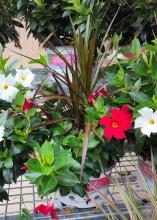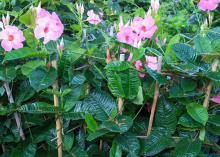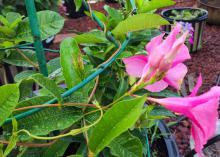Information Possibly Outdated
The information presented on this page was originally released on June 13, 2022. It may not be outdated, but please search our site for more current information. If you plan to quote or reference this information in a publication, please check with the Extension specialist or author before proceeding.
Mandevilla and Dipladenia: Although similar flowers, one is vine, other is shrub
If you like trumpet-shaped flowers, you may be familiar with both Mandevilla and Dipladenia, and you may even have them in your landscape. If you do, you probably realize they are very different, even if their blooms are a lot alike.
Dipladenia and Mandevilla are both great choices for Mississippi landscapes. You can count on both to provide a showy display of summertime flowers, but Mandevilla has better flowering characteristics, in my opinion.
It may be the similarity in bloom shape that leads these two plants to be marketed as the same thing, but Mandevilla and Dipladenia have different growth habits. Mandevilla is vining, and Dipladenia is more shrub-like.
While both are great plants, the problem comes when unsuspecting gardeners buy one of these plants that is labeled as the other. If you are looking for a vine and get a shrub, that’s a problem, so be careful at the garden center when choosing one of these plants.
It’s been my experience that plants listed as Mandevilla often do not climb. I have fallen for this mistake in the past. There’s been some breeding work done with Mandevilla and Dipladenia, and there are hybrids found at garden centers. This may contribute to the problem.
Dipladenia, which rhymes with gardenia, has a shrub-like growing habit and does not climb. One of its great uses is as the filler role in a combination basket or container because you don’t have to provide any support for it.
I actually like Dipladenia better than Mandevilla because you get the beautiful flowers and don’t have to worry about having a structure for them to climb. The flowers and foliage of Dipladenia are smaller than Mandevilla, but I feel this enhances their landscape value.
Keep consistent container moisture, but make sure it is well drained. Feed your Dipladenias every couple of weeks with a water-soluble fertilizer.
Sunlight encourages Dipladenia to bloom, and the plants need at least 6 hours of direct sun each day. In very hot locations, partial shade helps prevent the leaves from getting scorched.
Mandevilla is a climber that wraps its growing stems around any support it can find. You can make your own supports from hardware cloth, plastic mesh or other materials that give the plants a surface to scramble on. These structures can be as simple or elaborate as you like.
These climbing vines grow and flower best when planted in full sun. They tolerate partial shade in hot locations, such as south-facing walls. Make sure the soil in the planting bed is rich with organic matter to assure good drainage, but don’t let the soil dry out too much.
Mandevilla is very tolerant to pruning, and you can train the plant to grow in a shrub-like form. Flowers are produced on new growth, so there is little worry about pruning too much and eliminating blooms.
Mandevillas begin to flower in early summer and don’t quit until frost in the fall. They are tender plants usually killed by fall frosts. On occasion, they may grow back from the root system the following spring. Most gardeners simply treat Mandevilla as a flowering annual.
If you enjoy trumpet-shaped flowers, one of these plants will likely be a good addition to your landscape.




